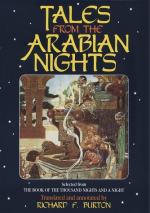[FN#317] The writer means the great Bazar, the Indian “Chauk,” which = our English Carfax or Carfex (Carrefour) and forms the core of ancient cities in the East. It is in some places, as Damascus, large as one of the quarters, and the narrow streets or lanes, vaulted over or thatched, are all closed at night by heavy doors well guarded by men and dogs. Trades are still localised, each owning its own street, after the fashion of older England, where we read of Drapers’ Lane and Butchers’ Row; Lombard Street, Cheapside and Old Jewry.
[FN#318] The local name of the Patna ganzes. The term was originally applied to the produce of the Coan looms, which, however, was anticipated in ancient Egypt. See p. 287 of “L’Archeologie Egyptienne” (Paris, A. Quantin) of the learned Professor G. Maspero, a most able popular work by a savant who has left many regrets on the banks of Nilus.
[FN#319] The great prototype of the Flying Carpet is that of Sulayman bin Daud, a fable which the Koran (chap. xxi. 81) borrowed from the Talmud, not from “Indian fictions.” It was of green sendal embroidered with gold and silver and studded with precious stones, and its length and breadth were such that all the Wise King’s host could stand upon it, the men to the left and the Jinns to the right of the throne; and when all were ordered, the Wind, at royal command, raised it and wafted it whither the Prophet would, while an army of birds flying overhead canopied the host from the sun. In the Middle Ages the legend assumed another form. “Duke Richard, surnamed ‘Richard sans peur,’ walking with his courtiers one evening in the forest of Moulineaux, near one of his castles on the banks of the Seine, hearing a prodigious noise coming towards him, sent one of his esquires to know what was the matter, who brought him word that it was a company of people under a leader or King. Richard, with five hundred of his bravest Normans, went out to see a sight which the peasants were so accustomed to that they viewed it two or three times a week without fear. The sight of the troop, preceded by two men, who spread a cloth on the ground, made all the Normans run away, and leave the Duke alone. He saw the strangers form themselves into a circle on the cloth, and on asking who they were, was told that they were the spirits of Charles V., King of France, and his servants, condemned to expiate their sins by fighting all night against the wicked and the damned. Richard desired to be of their party, and receiving a strict charge not to quit the cloth, was conveyed with them to Mount Sinai, where, leaving them without quitting the cloth, he said his prayers in the Church of St. Catherine’s Abbey there, while they were fighting, and returned with them. In proof of the truth of this story, he brought back half the wedding-ring of a knight in that convent, whose wife, after six years, concluded him dead, and was going to take a second husband.” (Note in the Lucknow Edition of The Nights.)




